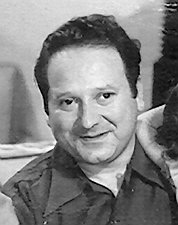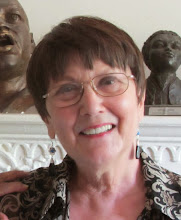This article by Alice Bernstein, Aesthetic Realism Associate and journalist, appeared in her regular column, “Alice Bernstein & Friends” in many newspapers nationwide. She co-authored, “Aesthetic Realism Explains the Economy” published in The Carpenter, (Jul/Aug1992), the magazine of the United Brotherhood of Carpenters and Joiners; and her story, "Union Leader Outlines Most Important Study for America,” about Timothy Lynch, president of Teamsters local 1205, appeared widely in 2002. About the present article, she adds the following:
"A love for carpentry and a passion for unions have been big things in my family. Both my grandfathers were carpenters in the early decades of the 20th century: Reuben Musicant was a stairbuilder and Aaron Schultz was a woodturner and joiner who died on a picketline in the 1930s. My father's older brother, Harry Musicant, was a carpenter and I have fond memories of watching him build window sashes in the workshop of a Brooklyn factory. The following is dedicated to them and to all who love fathers, carpentry, and beauty."
A Father, Carpentry, and Beauty by Alice Bernstein
As Father’s Day approaches, I think of my father Jack Musicant. He was one of the most fortunate people who ever lived. In 1946, when he and my mother May had been married five years and were parents of three little girls, experiencing the vexations, joys and hardships representative of many Americans, they had the good fortune to meet and begin studying Aesthetic Realism, the education founded by the great poet and critic Eli Siegel. What they learned made their lives happy, and I love them for enabling me to study this grand, kind, scientific education. “The deepest desire of every person,” Aesthetic Realism teaches, “is to like the world on an honest basis.” And the means to truly satisfying this desire is in the principle: “All beauty is a making one of opposites, and the making one of opposites is what we are going after in ourselves.”
Although Jack Musicant died many years ago, I learned that I still have the job of trying to know him and using him to like the world. And so I look at a question he had, which others have had, and which Aesthetic Realism explained in a way that made my father feel understood to his depths.
My Father, Jack Musicant

Carpentry Puts Together Thought and ActionMy father was a carpenter, and as a girl I liked to watch him use tools to build and repair many things. I remember the excitement of seeing him draw a plumb line with a chalked string, which he plucked to make it snap, creating an exact vertical line. I also learned from him the correct use of a level – the suspense of watching the bubble move until, there! it lined up in the exact center! The exactitude made for enormous pleasure!
Jack Musicant also liked to read and kept notebooks in which he pasted newspaper articles and copied passages from books. I had no idea that even as he cared for these things – carpentry and books – he also felt they were different and didn’t seem to go together.
Shortly before he died, my father wrote an essay, “My Fifty Years as a Working Man.” I am proud to quote Jack Musicant’s description of an Aesthetic Realism lesson he was privileged to have in 1953:
Mr. Siegel explained why I felt like a different person when I was studying than when I worked with my hands. He asked: “Can you combine thought and action?” I said No.
Mr. Siegel said he knew a person who felt he could only think while sitting down. “You have a feeling that thought is taking it easy, and when you are active that is something else. You’ve made a division between the resting and active life. Were you born with this division?”
JM: No, I wasn’t.
ES: You’ve been interested in words, and then in the active. Could a person punch a punching bag and still read Voltaire? Can you clench your fist and still think of America? You thought you should be very active, so you can give yourself the right to be in yourself later. Can you see thought as athletic? As you are listening to me, you are going through a lot of action. Thought is work. Trying to understand things takes energy.”
And he asked,
“Can you pound with your fist and say, ‘concept of justice’?”
As I pounded the table and said “concept of justice,” two things came together, and I felt very happy. I learned that honest pride comes from respecting reality and myself as a oneness of opposites. Mr. Siegel was going after my being a more integrated person. I saw it was possible to be actively thoughtful and physically active at the same time. For this I am very grateful, because my life, including my working life, took on more meaning. My mind had more energy, and my work became more careful and accurate. I had a new pride.

Jack Musicant, working

Thought and Hands Are OneI learned from Aesthetic Realism that my father represents the questions of all humanity. The burgeoning interest in home improvement -- with television shows, tools, and do-it-yourself stores – while very practical, also includes the hope in people to make thought and action, mind and body one. In his great essay “Art As Logic,” Eli Siegel writes:
“Thought goes on in art, and it is the very basis of art; it is art itself. It is thought that makes the hand right, and if the hand and eye help thought, why, then, hand and eye help logic: there is no reason why our bodies or senses should be seen as inevitably against logic.”
Ernest DeFilippis, Aesthetic Realism Consultant to men, has spoken and written importantly on this big subject. Recently we discussed notes of an Aesthetic Realism class early in his study when he was doing carpentry work. Like Jack Musicant, he spoke about feeling a division between wielding a hammer and studying literature, and Mr. Siegel explained to him, “Force is anything that can affect something else. It’s usually seen as physical, but there’s no such thing as body work without mind, thought. Mind is a force.” And with beautiful imagination, Mr. Siegel illustrated this by singing a popular folk song, and changing the last word:
There ain’t no hammer
On the side a this mountain
That rings like mine boys
That rings like mind!
In seminar papers and art talks at the not-for-profit Aesthetic Realism Foundation (www.AestheticRealism.org), Mr. DeFilippis has spoken about the immense value of this education, including what he learned from Mr. Siegel about the aesthetics of carpentry and the15th century Italian artist, Lorenzo Ghiberti. In a thrilling talk, “Ghiberti’s Bronze Doors—or, How Can Men Make Sense of Mind and Body?” given by Mr. DeFilippis in the Terrain Gallery’s historic series “Aesthetic Realism Shows How Art Answers the Questions of Your Life,” he discussed these doors which Michelangelo said, “might fittingly stand at the Gates of Paradise.”
Quoting Ghiberti’s description of “infinite delicacies which the eye alone cannot grasp, but which only the hands can discover by feeling,” Mr. DeFilippis said that the artist saw hands as an extension of mind. He continued:
“I’m very grateful to Eli Siegel for encouraging me to study…the relation of hands and mind with more accuracy, wonder and joy. As I do carpentry work now, I have come to see there is a dialogue between my hands and mind. For example, as I am chiseling, digging a groove, making an edge or a curve, my mind has an idea, a picture of what it should be and my hand responds to it and also says what it thinks. As my finger runs along an edge it might suggest, ‘it’s got to be sharper; it doesn’t feel right this way,’ or mind will say to hand, ‘don’t make the groove too deep, go easy, keep it shallow.’ And when I stop and look, there is a feeling of wholeness because hands and mind have worked together to try to make something beautiful.”
Beauty in a Hammer and a Crowbar

Sledge Hammer and Crowbar from Hardware,
64 etchings by Steven Stankiewicz
I remember feeling wonder about the variety of tools in my father’s workshop, including a micrometer which measured the thickness of wires, some as fine as a hair; and a power saw which could cut a tree trunk with ease. I love Aesthetic Realism for encouraging me to think about the people in history who used their minds to devise the right tools for all kinds of work. Recently at the Terrain Gallery, I was stirred by Steven Stankiewicz’s bound book of 64 etchings, titled Hardware: a homage to tools: wrenches, pliers, hatchets, bolt cutters, hammers, saws, power tools, dancing calipers. The artist’s lovingly exact, sometimes mischievous rendering of these tools, had me see opposites in the world, the workman, and in myself in new ways.
There is a proud and humble sledge hammer, standing modestly, bathed in radiant light. While this simple object with its heavy head and slender handle has the power to smash matter, we feel through the delicate lines and the subtle changes of light and dark, a soul within, faintly trembling, perhaps even yearning, to be known. And there is a severe and jolly crowbar. This solid, heavy object - made of dense metals enabling it to pry loose the hardest spikes - has jaunty curves depicted by exquisite cross-hatching making its blackness velvety. Though it weighs a number of pounds, the backlighting sets it out daintily in silhouette. And little star bursts of light running along its edges, cheerfully lift up all that heavy, black weight. We respect the mind of the artist and others who came to these useful, beautiful objects.
These, then, are instances of using Jack Musicant to know and like the world, which I look forward to continuing all of my life.
Alice Bernstein is an Aesthetic Realism Associate and journalist whose articles appear nationwide.
 Alice Bernstein is a journalist and Aesthetic Realism Associate whose articles and regular column, “Alice Bernstein & Friends,” appear nationwide. She is the editor and co-author of the anthology Aesthetic Realism and the Answer to Racism (Orange Angle Press, 2004). Mrs. Bernstein was born and raised in Brooklyn, New York, where she attended Abraham Lincoln High School, and majored in English literature at Brooklyn College. She is grateful to her parents, the late Jack and May Musicant, who were among the earliest students of Aesthetic Realism with Eli Siegel, for encouraging her desire for knowledge and her interest in people of all faiths, races, and backgrounds. Alice Bernstein had the honor to study in classes with Eli Siegel, and continues her studies in professional classes taught by Ellen Reiss at the not-for-profit Aesthetic Realism Foundation in New York City.
Alice Bernstein is a journalist and Aesthetic Realism Associate whose articles and regular column, “Alice Bernstein & Friends,” appear nationwide. She is the editor and co-author of the anthology Aesthetic Realism and the Answer to Racism (Orange Angle Press, 2004). Mrs. Bernstein was born and raised in Brooklyn, New York, where she attended Abraham Lincoln High School, and majored in English literature at Brooklyn College. She is grateful to her parents, the late Jack and May Musicant, who were among the earliest students of Aesthetic Realism with Eli Siegel, for encouraging her desire for knowledge and her interest in people of all faiths, races, and backgrounds. Alice Bernstein had the honor to study in classes with Eli Siegel, and continues her studies in professional classes taught by Ellen Reiss at the not-for-profit Aesthetic Realism Foundation in New York City. ung people.” The project was awarded grants in 2007 from the Puffin Foundation and the Yip Harburg Foundation.
ung people.” The project was awarded grants in 2007 from the Puffin Foundation and the Yip Harburg Foundation.







